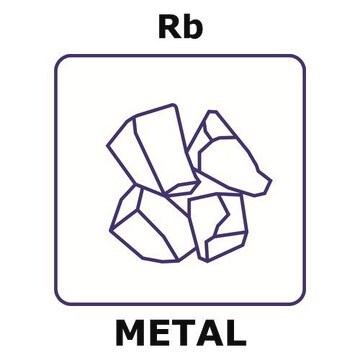276332
Rubidium
ingot, 99.6% trace metals basis
About This Item
Produtos recomendados
Ensaio
99.6% trace metals basis
forma
ingot
adequação da reação
reagent type: reductant
embalagem
pkg of Packaged in: Breakseal Ampule
resistividade
11.0 μΩ-cm, 20°C
Impurezas
0.2-0.4% Cs
pb
686 °C (lit.)
pf
38-39 °C (lit.)
densidade
1.53 g/mL at 25 °C (lit.)
cadeia de caracteres SMILES
[Rb]
InChI
1S/Rb
chave InChI
IGLNJRXAVVLDKE-UHFFFAOYSA-N
Procurando produtos similares? Visita Guia de comparação de produtos
Categorias relacionadas
Descrição geral
Aplicação
It can also be used as a reducing agent to synthesize reduced polycyclic aromatic hydrocarbons.
Palavra indicadora
Danger
Frases de perigo
Declarações de precaução
Classificações de perigo
Eye Dam. 1 - Skin Corr. 1B - Water-react 1
Perigos de suplementos
Código de classe de armazenamento
4.3 - Hazardous materials which set free flammable gases upon contact with water
Classe de risco de água (WGK)
WGK 3
Ponto de fulgor (°F)
Not applicable
Ponto de fulgor (°C)
Not applicable
Equipamento de proteção individual
Eyeshields, Faceshields, Gloves, type P3 (EN 143) respirator cartridges
Certificados de análise (COA)
Busque Certificados de análise (COA) digitando o Número do Lote do produto. Os números de lote e remessa podem ser encontrados no rótulo de um produto após a palavra “Lot” ou “Batch”.
Já possui este produto?
Encontre a documentação dos produtos que você adquiriu recentemente na biblioteca de documentos.
Os clientes também visualizaram
Nossa equipe de cientistas tem experiência em todas as áreas de pesquisa, incluindo Life Sciences, ciência de materiais, síntese química, cromatografia, química analítica e muitas outras.
Entre em contato com a assistência técnica












